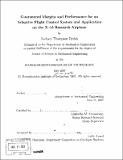Guaranteed margins and performance for an adaptive flight control system and application on the X-15 research airplane
Author(s)
Dydek, Zachary Thompson
DownloadFull printable version (6.327Mb)
Alternative title
Robustness margins and high performance for an adaptive flight control system with application to hypersonic vehicles
Other Contributors
Massachusetts Institute of Technology. Dept. of Mechanical Engineering.
Advisor
Anuradha M. Annaswamy.
Terms of use
Metadata
Show full item recordAbstract
The design tools developed for use with linear controllers such as gain and phase margins do not apply to nonlinear control architectures such as adaptive control. For decades, flight control engineers have used these tools extensively to measure the robustness of their linear control systems and make guarantees on the performance of the closed-loop system in the presence of uncertainties. Stringent demands on performance for safety-critical flight systems, as in the case of hypersonic vehicles, make advanced control methods such as adaptive control increasingly attractive. The major obstacle in the widespread application of adaptive control to such applications is the lack of guarantees on performance and robustness. This thesis presents robustness margins, adaptive control analogs to the linear control notions of gain and phase margins, which can be used to make those guarantees. This paves the way for a systematic Verification and Validation (V&V) approach for adaptive controllers. The operation of an adaptive controller can be broken down into two distinct phases: the adaptation mode, in which the adaptive parameters are varying, and the steady-state mode, in which the adaptive parameters have converged to their steady-state values. (cont.) During the steady-state mode, the nonlinear adaptive controller converges to a linear time-invariant (LTI) system, and many tools exist for the calculation of the requisite margins. However, during the adaptation mode, which is arguably a more crucial mode of operation for the aircraft, no such tools exist. This thesis provides the tools for the numerical calculation of robustness margins during the adaptation mode. Robustness with respect to a range of uncertainties including parametric uncertainties, disturbances, time-delays, unmodeled dynamics, and actuator saturation is derived. The robustness of the adaptive controller is then demonstrated on a fully nonlinear model of a high-performance hypersonic aircraft. The importance of theoretically justified adaptive controllers is illustrated using the historical example of the NASA X-15 research airplane. NASA's three X-15 aircraft together flew nearly 200 flights, acting as test beds for many bleeding-edge technologies, including the nonlinear adaptive controller implemented on the X-15-3. The application of this controller demonstrated the advantages of adaptive control including improved performance and a shorter design cycle. (cont.) However, when the X-15-3 crashed in 1967, one of the severe disadvantages of this early adaptive control was highlighted: the lack of guaranteed stability and performance. Using modern adaptive control theory and the tools developed in this thesis, the control design of the X-15 is revisited and it is demonstrated that had the X-15 controllers been implemented today, all of the 200 flights, without a single exception, would have been performed safely, without incident.
Description
Thesis (S.M.)--Massachusetts Institute of Technology, Dept. of Mechanical Engineering, 2007. Includes bibliographical references (leaves 59-61).
Date issued
2007Department
Massachusetts Institute of Technology. Department of Mechanical EngineeringPublisher
Massachusetts Institute of Technology
Keywords
Mechanical Engineering.